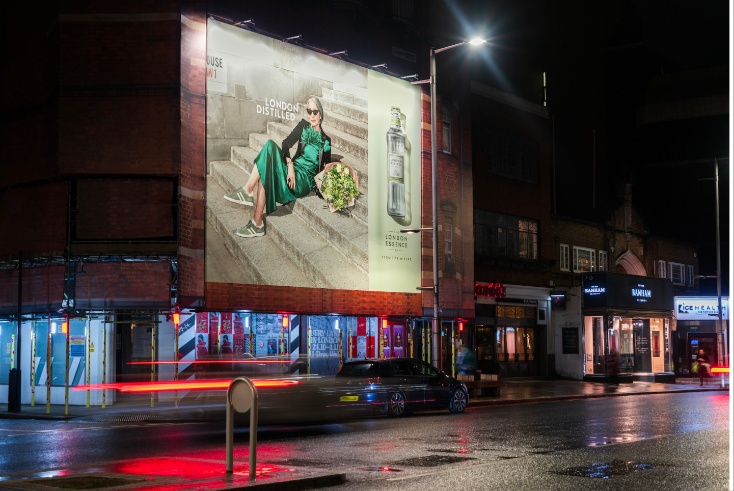Opinion
Fake out-of-home comes in many forms and out-of-home can embrace some of them to add a string to its bow.
One of the big media talking points of 2023 has been the rise of what has been christened ‘faux out-of-home’ (FOOH).
For the uninitiated, FOOH is hyper-realistic augmented reality or CGI videos that give the impression they are real OOH activations.
The first and most obvious criticism of is simply one of trust — that FOOH deceives the public by pretending to be something it isn’t.
Some have even questioned whether FOOH has broken the law.
It’s worth remembering that 50% of the money spent on OOH goes back to local communities through funding valuable infrastructure such as bus shelters and free Wi-Fi, so there is an argument that brands are enjoying the benefits of OOH at the expense of the public.
I’d argue, however, that the issue of FOOH is far from an open and shut case.
The genie’s out of the bottle
For starters, not all FOOH is created equal.
There have been some particularly egregious examples where brands have simply tried to pass off campaigns that never happened as if they did (you know who you are!)
However, there is a second category of FOOH into which I’d place campaigns such as the recent Maybelline Tube Mascara ad. The content, which sees a London Underground train with a giant eyelash pass under an equally giant mascara brush as it pulls into a station, is brilliantly executed.
The simple fact is that this campaign could never have taken place in reality. Transport for London has some of the most stringent safety requirements in the world — especially when it comes to ‘cross track’ advertising.
Secondly, it was never Maybelline’s intention to convince people the campaign was real. As Fernando Febres, VP of Marketing for Maybelline US, remarked in a recent interview: “It was a way to honestly disrupt the environment and get people talking, and wondering, ‘Is it real or is it not?’”
Thirdly, nobody could accuse Maybelline of not investing in OOH. We recently worked with them on the UK’s first national 3D OOH campaign for the brand’s Falsies Surreal Extension Mascara. The campaign delivered 3.5 times sales uplift verses static creative, with its success in the UK seeing it launched in other markets.
So, while the FOOH ad drove huge organic world-wide reach and awareness for the brand, the real-world 3D execution drove people into shops to purchase the product. This is because, despite the name, FOOH isn’t out-of-home, it’s social content.
We know that social and out-of-home work brilliantly together with countless examples of OOH activations providing a real-world anchor for social campaigns. With the FOOH genie out of the bottle, it is time to be talking about how FOOH and real-world OOH can coexist and complement each other as part of a wider campaign.
How can fake and real work together?
We’ve already seen FOOH and OOH start to work together to deliver results for brands in our work.
One fabulous recent example was a campaign for the London Essence Co promoting its premium mixers. The campaign perfectly blends a real site — a stylish banner in east London (pictured, main image) — with a ‘FOOH’ activation.
The viral social content sees a London cab with a huge cocktail glass on its roof pull up in front of the billboard before a giant hand takes the bottle from the advert and pours it into the glass set upon a London taxi.
Here, the advertiser gets the best of both worlds. An unmissable billboard in a location that hits the right audience as well as quirky and engaging social content.
Expect this blend of real and FOOH to be a growth area in 2024 as creatives become more playful with this kind of hybrid campaign and brands reap the rewards both online and in the real world.
This is really just an example of OOH doing what it always does — adapt as technology evolves, as brands seek new ways to reach audiences. The creativity is the content.
Another powerful string to our bow
In reality, we don’t need to fear FOOH. OOH offers a unique platform with capabilities that set us apart from FOOH and other social content channels.
OOH enjoys the highest reach of any commercial channel, making it the most inclusive channel. Our strengths lie in areas such as establishing trust, creating strong brand awareness, and fostering brand saliency.
OOH is at the forefront of harnessing the advantages of cutting-edge technologies like smart data and automation, which provide brands with real-time opportunities to influence consumer behaviour, driving consideration and purchases.
Consumers have been happy switching between the real world and online for years, with 60% of online purchases now occurring beyond the confines of home.
Blending real-world campaigns with online activations can be yet another powerful string to OOH’s bow, that advertisers should consider incorporating into a broad range of campaigns.
Nicole Lonsdale is chief client officer at Kinetic Worldwide, GroupM’s OOH division
Adwanted UK is the trusted delivery partner for three essential services which deliver accountability, standardisation, and audience data for the out-of-home industry.
Playout is Outsmart’s new system to centralise and standardise playout reporting data across all outdoor media owners in the UK.
SPACE is the industry’s comprehensive inventory database delivered through a collaboration between IPAO and Outsmart.
The RouteAPI is a SaaS solution which delivers the ooh industry’s audience data quickly and simply into clients’ systems.
Contact us for more information on SPACE, J-ET, Audiotrack or our data engines.





